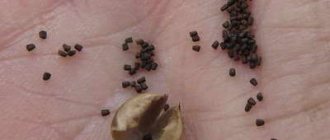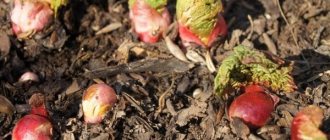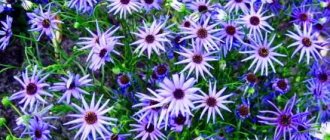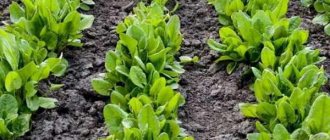For those who adhere to an “informal” style in landscape design, a herb garden is a real find. A garden in which herbs reign is not an invention of today, but an ancient tradition that is coming back into fashion again. If you have a small free space on your property that you would like to decorate with ornamental plants and use to the fullest, then an “aromatic” vegetable garden is what you need. From herbs you can build a flower bed, a border and, in the end, an ordinary garden bed. Read the article about which herbs are best grown in an “aromatic” garden.
Spices
Perennial herbs
- Mint
There are approximately 25 species of mint, which are used primarily as a flavoring addition to tea. Loves loose, fertile soils and grows equally in sun and shade.
Watering is moderate: it does not tolerate stagnation of water, but it also withers from the heat. Mint is propagated both by seeds (a rather labor-intensive method, moreover, it is not suitable for hybrids), and by cuttings, by dividing the bush. It grows well in one place for 3 – 4 years. Mint bushes grow strongly, which must be taken into account when planting.
- Melissa
Melissa is very similar in appearance to mint, but differs from it in its characteristic lemon aroma and less aggressiveness (it does not grow as much).
Melissa is unpretentious, except that she is afraid of severe frosts. It propagates in the same ways as mint. The herb is perfect not only for tea, but also as a seasoning for meat, vegetable dishes and home-canned food. In addition, it is used in medicine and cosmetology.
- Sage
Sage is good not only for its tart aroma, but also for its lovely blue flowers. Fresh and dried herbs are used as a seasoning for various dishes. There are several types that vary in height, color and soil requirements.
Oak and meadow sage loves sun, non-acidic and fertile soil, and moderate watering. And sticky sage tolerates slight shading well. All species require winter shelter and spring pruning. All three methods of reproduction are possible.
- Oregano
Oregano is known in cooking as oregano. The oregano genus has many species, one of them is marjoram. It is very thermophilic and is grown in the middle zone only in summer, so we will talk about it in the annuals section. In the meantime, let's talk about common oregano, which overwinters well without shelter.
It is found almost everywhere. You don’t even have to buy seeds - just dig up roots in the meadow. Oregano can grow both in the sun and in partial shade, but in the first case it accumulates much more essential oils. Watering is required only in severe drought; it prefers low-fertility soils.
- Tarragon
Tarragon (tarragon) grows up to 1.5 m. It is used for preparing various dishes and in pickles. It is undemanding to growing conditions; it only does not tolerate full shade and excessively wet places.
Propagated by root suckers, dividing the bush and cuttings. But it’s better not to grow it from seeds, because the piquant aroma is lost. It is advisable to renew the bushes every 3 to 5 years.
- Rhubarb
Rhubarb is a truly universal herb that is suitable for compotes, pies, candied fruits, and wine. This herb grows up to three meters in height, and its lower leaves are quite spreading, so it will require enough free space and sun. Prefers black soil, but other slightly acidic soils without stagnant water are also suitable.
The crop is propagated both by seeds and by dividing the rhizome. Strong leaves that can be eaten appear in the second year. And it can grow in one place for more than 10 years.
- Sorrel
Another sour herb used in pies (and also in salads and hot dishes) is sorrel. Edible foliage is already a delight in the spring. The plant is short-growing, especially if flowering is prevented in time.
Unpretentious, loves light and partial shade, neutral and slightly acidic fertile (loamy or peaty) soils and regular watering. Easy to grow from seeds - you can sow them directly into open ground. The plant needs to be replanted every 4 years.
- Horseradish
Horseradish, of course, is not sweeter than radish, but an excellent find for lovers of spiciness. The leaves and roots are eaten. Can be planted in sun or partial shade, as long as the soil is not heavy.
Watering is only needed during drought. Care consists of weeding and loosening. It grows in one place for up to 10 years, but the best taste is given by young roots. Propagated by cuttings. Keep in mind that horseradish grows, harassing neighbors.
- Celery
Celery is related to dill, parsley, caraway and many other umbelliferous plants. It is biennial, but more often it is grown for only one year, because the stem and roots are mainly used, but not the seeds. This culture is consumed in salads, sauces, and drinks (for example, in a weight loss cocktail). Leaf, root and petiole subspecies of celery are known.
They all love loose, neutral or slightly acidic fertile soil, sun or slight shade. The differences are that the leaf and petiole species can be sown with seeds (in the southern regions of the country or in warm spring) or grown as seedlings, while the root species can only be grown as seedlings. Petiole requires high hilling.
- Lovage
Lovage is similar in appearance to celery, but its aroma is more delicate. The culinary spectrum is very wide: from salads to baked goods. This massive bush reaches 2 meters in height and grows quickly, so plant it away from its low-growing neighbors.
Prefers moderately moist and well-drained soils. It tolerates both sun and shade, so it is best to give it some shade. Propagated by seeds, cuttings and dividing the bush.
- Asparagus
Asparagus (asparagus) has a wide range of uses. Its young shoots are useful in salads, main courses and canned food, and a coffee drink is made from ripe berries.
The yield is low, because few shoots are produced from one bush, but they are very tasty and healthy. Prefers fertile, especially sandy soils. Loves sunny places, moderate watering, but does not die in drought (from experience). It is best to propagate by dividing the bush and not messing with the seeds.
- Caraway
Cumin is a biennial plant: in the first year only leaves appear, and in the second year the seeds appear, which are used in cooking. They are appropriate in meat and vegetable dishes, and are also suitable for baking. The grass loves sunny places and loose soil fertilized with organic matter.
Arugula
- Arugula is a plant from the cabbage family known for its beneficial and tasteful qualities.
It is very easy to grow, as it is undemanding; it can be planted several times a season, since the most delicious are the young leaves, which are 20-50 days old. The only thing you need to consider before planting is the acidity of the soil, since this unpretentious crop will not grow on acidic soils. Arugula does not really like the cold, and does not tolerate temperatures below -7 degrees and stops developing. The ideal temperature for growing it is +16.
Before planting, dig up the bed well and go over it with a rake. We make grooves in the garden bed; they should not be deep, no deeper than 10-15 mm, and the distance between the grooves should be at least 15 centimeters. Before planting, we moisten the soil and plant the seeds at a distance of 3-10 centimeters from each other. After planting, cover the furrows with soil. If you planted seeds in early spring, then it is better to cover the beds so that the seeds germinate when the first shoots appear, and the weather still remains cool, then you should open the film only during the day. Harvesting can be done when the leaves reach 10 centimeters.
Arugula does not require special care; you only need to water the plant abundantly to keep the leaves juicy.
Annual plants
All annuals reproduce by seeds, which you can easily harvest yourself.
- Dill
Dill is the most common seasoning. Fresh greens are put in salads, served with various dishes, dried greens are put in soups, and umbrellas are put in pickles. Growing dill is not difficult: the seeds germinate well, and care consists of watering a couple of times a week, weeding and loosening. But even without weeding, the greenery grows so much that it can sow the entire area. The soil is suitable neutral or slightly acidic.
- Parsley
Parsley, depending on its purpose, can be root or leaf; it is not forbidden to “confuse” varieties. The roots are added to homemade preparations, and the greens are added to almost every second dish. Parsley loves loose neutral or slightly acidic soils, grows in sun and partial shade, and requires regular watering without waterlogging.
- Cilantro
Cilantro produces bitter leaves with a spicy aroma, and with proper care, it also produces tasty seeds called coriander. Greens are used in salads, and the seeds are suitable for almost any dish, and are used in baking Borodino bread.
Most often, coriander is grown in the southern regions of Russia, but this is also possible in the middle zone. In my mother’s greenhouse, Nizhny Novgorod region, it self-sows. Cilantro is demanding of moisture and loosening, and tolerates light and partial shade. The soil can be neutral or moderately acidic.
- Basil
Basil attracts not only with its beneficial properties, but also with its bright color. The purple varieties are especially beautiful. In addition, pollinating insects tend to flock to its flowers.
All above-ground parts of the plant are eaten. The herb is good in salads, first and second courses and in baked goods (for example, pizza). Grows in sunny areas with light, loose soils, does not like stagnant water. To avoid diseases, it is necessary to change the planting site annually.
- Chervil
Chervil (Kupir) is used in salads and meat dishes. The root of some species is also edible and is used to make cheeses.
The plant thrives in sun and partial shade and is not picky about soil. It can even be planted in the garden under the canopy of trees. Seeds are sown in early spring, and then until mid-May you can sow again to always have fresh greens on hand.
- Anise
Anise seeds and greens are used to prepare salads, soups, baked goods, fish and meat dishes. In the garden it repels harmful and attracts beneficial insects. The plant loves sandy loam and chernozem loose soils fertilized with phosphorus and humus. Requires regular watering, but does not tolerate excessive humidity.
- Borago
Borage, or borage (it has many names, borage and borage are also found) produces fragrant foliage for salads, and the roots, collected in the fall, add an excellent taste to sour cream, wines, cheeses, etc. Attracts bees and repels Colorado potato beetles. This plant is not picky about soil and can grow in strong shade.
- Arugula
Arugula is used to season salads, sauces, soups, savory pastries and other dishes. In the southern regions, seeds can be sown in mid-April, and in the north, cultivation in greenhouses or through seedlings is recommended. The plant is demanding of light, but in hot weather it prefers partial shade. It loves moisture, but should be watered carefully so as not to damage the fragile leaves.
- Marjoram
Marjoram is great for sauces and soups, as well as for main courses, compotes and baked goods. Prefers bright places, light and loose soils that are not waterlogged or overdried. Appreciates frequent watering and fertilizing.
Since the crop is heat-loving, it is recommended to grow it through seedlings in the middle zone.
- Leaf mustard
Leaf mustard is a salad crop and, what is important for gardeners, an excellent green manure (green manure). It tolerates cold well, so you can grow it in a greenhouse in early spring, and then sow every two weeks to constantly have fresh greens. Loves peat and soddy-podzolic soils. It needs loosening and timely watering, and with a lack of moisture it loses its taste.
The list is, of course, incomplete. What you plant in your garden depends on the area, soil type and your taste. Maybe we haven't talked about something very useful yet? Share in the comments!
Principles for making and placing spice beds
It is best to place a herb bed near a seating area, entrance or in the garden. Flowerbeds are laid out from stone or brick, and sprinkled with gravel around the perimeter. The step-by-step construction of a spice bed looks like this:
- After the location for the flower bed has been decided, the ground on the site is cleared of debris and weeds and dug up.
- The shape is outlined using pegs and rope.
- A narrow trench 10 cm deep and approximately 8–10 cm wide is dug along the outer perimeter.
- Geotextiles are placed in the trench so that it covers not only the bottom, but also the sides. To prevent the canvas from moving, it is temporarily supported with pebbles.
- The trench is filled with crushed stone or gravel to the soil level. Such a fence will look beautiful in the garden and protect the spices from weeds.
- Seedlings are planted in the prepared area with a step between plants of at least 20 cm, because the spices will grow wildly. Annual herbs can be planted in between the perennials.
What does a spice bed look like
? A bed or flower bed is decorated with decorative stones, shards or other objects.
Thyme
Thyme (thyme) is sown for seedlings in the second half of March, and planted in beds from mid-May. This spice loves sunny or partial shade areas with light, nutritious, drained soil and prefers moderate watering.
At the beginning of spring and after flowering, thyme stems should be shortened by a third. It propagates by cuttings and division.
Marjoram
Due to the very small seeds of marjoram, it is advisable to grow it through seedlings. Seeds need to be mixed with sand and sown in boxes with soil mixture in early April. Seedlings are planted in open ground after the end of return spring frosts, at the end of May or beginning of June.
Marjoram prefers light areas, protected from wind and drafts, and loamy or sandy soil. The soil on which potatoes previously grew is ideal. This spice also loves timely watering and weeding.
Sage
Sage (salvia) sprouts well, so you can safely sow it in March-April or in the fall under snow.
This spice prefers soils with moderate acidity and well-lit areas, feels comfortable on light, fertile and loamy soil, and tolerates drought. To obtain juicy and tender sage greens, regular moderate watering is required.
- Author: Inna Kiseleva
Rate this article:
- 5
- 4
- 3
- 2
- 1
(10 votes, average: 3.9 out of 5)
Share with your friends!
Salad with petiole celery
Ingredients: stalked celery – 2 pcs.; salad cucumber – 1 pc.; sweet pepper – 1 pc.; green onions – 1 bunch; Chinese cabbage - a small head of cabbage; feta cheese – 100 g; vegetable oil and vinegar (can be replaced with lemon juice) to taste.
Preparation. Wash and peel the vegetables. Chop the cabbage into strips, finely chop the green onions and lightly rub everything with salt. Cut the celery into pieces, cucumber, pepper and cheese into cubes. Mix everything and add salt to taste. In a bowl, beat vegetable oil with vinegar or lemon juice, season the salad with the resulting sauce.
Tarragon
Frost-resistant and light-loving tarragon (tarragon) does not like damp and dark places. It prefers moist, well-drained sandy loam soil. Tarragon is sown in open ground in early spring or autumn. It is recommended to mix the seeds with sand to avoid crowded planting.
In the Non-Black Earth Zone, tarragon seeds do not germinate, so here you need to grow the plant through seedlings, which are planted in the beds in June.
Ruta
The unpretentious fragrant rue blooms in July, in the second year of growth. She loves southern, windless slopes with light, moist soil and feels comfortable in calcareous, loamy and crushed stone soil. Rue is resistant to drought, diseases and pests.
Seeds are sown in the ground in early April or late autumn; planting with seedlings is preferable. Propagation by cuttings or dividing the bush is possible.
Mint
Mint seeds are sown in the ground in mid-April or early August. Seedlings are planted in the second half of May.
The plant loves sunny or slightly shaded areas, located away from cabbage, beets and cucumbers. Mint prefers moist and loose soil, saturated with nutrients - there it can even take over neighboring areas, displacing other crops.











